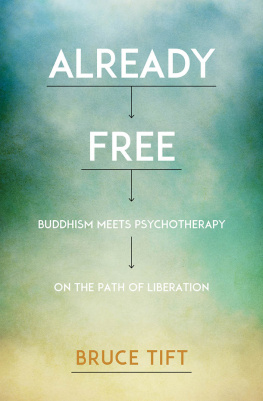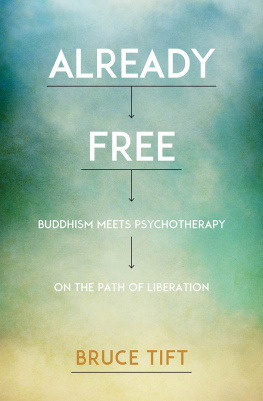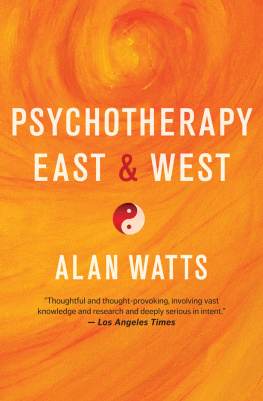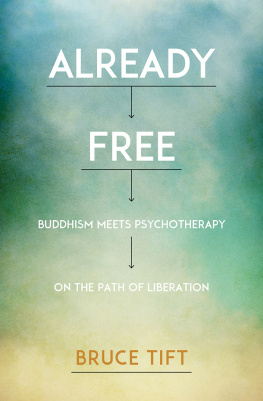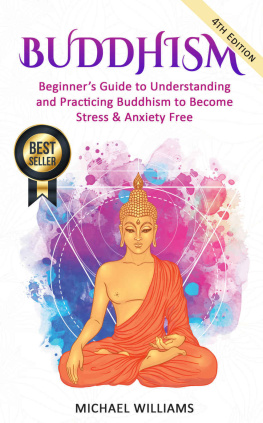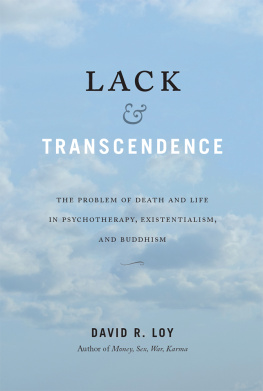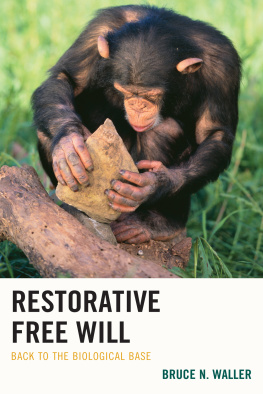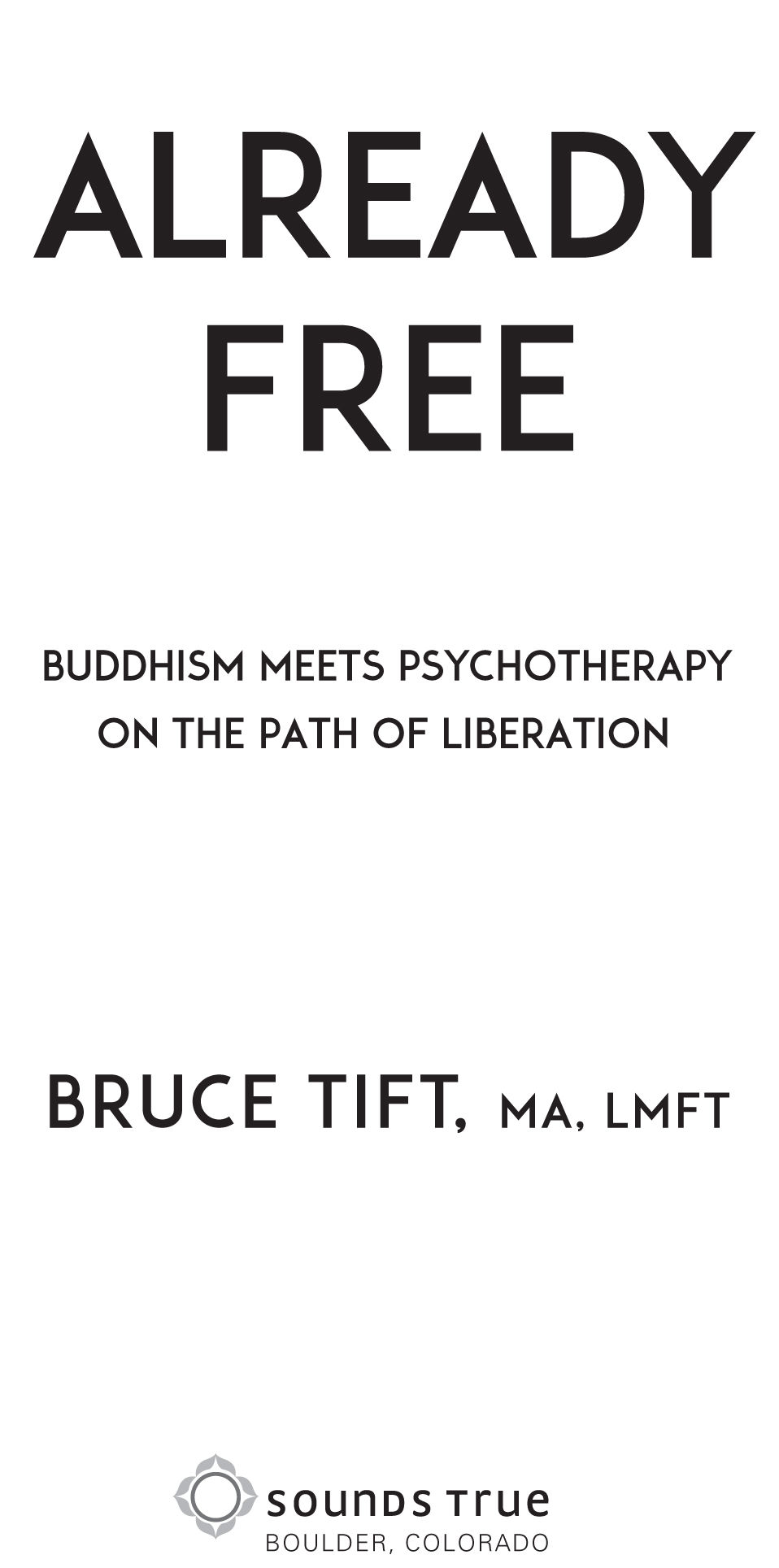
To my parents, Kay and Floyd
My sister, Barbara, and brother, David
To my wife, Reva
My daughters, Rachael, Ciel, and Elena
To my teacher Chgyam Trungpa, Rinpoche,
my teacher Shyalpa Tenzin, Rinpoche,
and his teacher HH Chatral, Rinpoche
With deep appreciation
CONTENTS
FOREWORD BY TAMI SIMON
ONE OF THE AREAS of inquiry that is endlessly fascinating to me, like a jewel that I could hold in my hand, turn over, and continually marvel at, is: How do the discoveries of meditation and the discoveries of psychotherapy fit together? How do we build a healthy self and discover the lack of any enduring self at the same time?
When I had the chance to sit down and talk with Bruce Tift, Boulders most well-known Buddhist psychotherapist, I of course wanted to bring out this jewel of a question and explore. Perhaps Bruce could help me make sense of how the Buddhist path and the path of psychotherapy fit together? I knew I was benefitting greatly from the regular work I was doing with a psychotherapist (reports from other people, especially my intimate partner, were that I was becoming much more available in relationship, for example). I also knew I was benefitting tremendously from the practice of meditation, discovering how to rest and be more and more at home in the wide, open space of awareness. But these two approaches felt like separate tracks. Perhaps Bruce could help me understand and articulate a unified vision?
When I asked Bruce about this and how he worked with his psychotherapy clients and students, he said, I alternate between a Buddhist approach and a psychotherapeutic approach without any hope of resolution.
Excuse me? I thought. No hope of resolution. I had been searching for some grand unified theory, and here this expert was explaining that he alternated between the two approaches based on what was needed in the moment, knowing that each path had different blind spots and offered different gifts.
As I considered his response to me, I suddenly felt like I was on a beach drinking a pia colada. I mentioned this to Bruce. He smiled at me, as if he were saying, What is so bad about that? Could I entertain a dialogue, a meeting, if you will, between the teachings of Buddhism and the practice of psychotherapy that wasnt about definitive conclusions but instead about opening my mind wide like sitting on the beach and looking out at the ocean? Could the inquiry be that spacious, enjoyable, and un-problematic?
Bruce Tift is an unusual teacher. He writes and teaches from his own experience and the perspective that our lives are not problems to be solved. He approaches the meeting between Buddhism and psychotherapy with a deep pragmatism, employing the best that each approach has to offer in a welcome embrace of contradictory energies.
His specialty, if you will, is the unwanted, the neglected, the disownedthose parts of ourselves that we would rather disavow than confront. In Already Free, Bruce invites us, again and again, to turn toward our disturbance, not away. Now why would this be of interest? Why might we want to turn toward our fear and anxiety and feelings of desperation? Bruce makes the very good point that if we want to be free, then we cant have walled-off pockets of experience that we spend our life avoiding. If we want to experience what Bruce calls being undivided, then we need to have the capacity to be with intense (even if unwanted) experience, without cutting off and separating from the intensity.
According to Bruce Tift, Sanity is a counter-instinctual process. And at first, it certainly feels counter-instinctual to turn toward what is painful and terrifying. Shouldnt I be running as fast as I can in the opposite direction? But the counter-instinctual move turns out to be tremendously empowering. If we can face our worst fears, then maybe they wont continue to secretly run our life. And where does real confidence come from if not from knowing that we can handle whatever experience comes our way?
So how do we engage with the difficult and unwanted? Bruce teaches his clients and students how to practice what he calls embodied immediacyin whatever moment we find ourselves, in the immediacy of this moment, we experience our physical sensations without analysis or interpretation. We are with the flutter in our stomach, the heat in our hands, the pounding in our heart. And we stay with it and stay with it.
In my own life, I have found this practice of embodied immediacy to be of central importance. Often when I find myself in some type of neurotic spin, worried about this or that fictitious possibility, what is clearly needed is a return to embodied immediacy. There is something happening in my body that I am avoiding feeling through mental spin. In fact, Bruce writes, disembodiment is a requirement of neurosis.
Bruce Tift is wise, provocative, and above all, practical. Already Free is not so much a theoretical book as it is an actual handbook to realize the open ground of our being. Bruces approach to freedom is not transcendent but instead all-inclusive. The freedom Bruce describes is not a freedom from any experience but a freedom that welcomes every experience as intelligent and meaningful.
Take for example the experience of anxiety. Bruce offers the counter-instinctual advice that we can commit to the feeling of anxiety as an approximation of an open state of mind. Instead of viewing anxiety as something that we need to get rid of, we are invited to commit to it, to stay with the experience and discover its intelligence. There are so many books and teachers that try to cure us or try to pump us up, encouraging us to achieve some future positive state. Bruces approach is different. What if we are already free? What if even our intense anxiety is not actually a problem, but instead, as Bruce writes, an intelligent response to the perception of groundlessness from the egos point of view?
Being able to commit to our disturbance when we are alone, perhaps on the meditation cushion or lying in bed, is one thing, but committing to disturbance in relationship, in my experience, is of a whole different order of magnitude. Bruce writes in Already Free that he thinks it is accurate to say that in his forty-year relationship (a relationship that appears to be loving and committed), he has found himself disturbed every day. I found that statement so shocking, refreshing, and normalizing! Most spiritual teachers who write about the open ground of being never discuss disturbance in relationship, and yet in my experience, it is where so much of our personal growth lies. Fortunately, Bruce devotes two chapters to exploring our patterns in intimate relationships and how we can benefit from the teachings of both Buddhism and psychotherapy to explore what triggers us and why, how to replace blame with personal responsibility, and how to find a freedom in intimacy that honors our need for separateness as well as our need for closeness.
Bruce Tift is confrontative. He confronts us with our patterns of escape and he confronts us with our freedom. Read Already Free as a process of inquiry, as a way to grow in consciousness, and ultimately, as a way to discover a freedom that leaves nothing out.
INTRODUCTION
RECENTLY A YOUNG MAN in his mid-thirtieswell call him Darrenwalked into my office. He was looking for help with a recurring pattern he had noticed in his life. In brief, he had a very hard time following through on almost anything he started. He would leave relationships after they became too serious; he would find a reason to change his job or even his entire career just as he was approaching success; and while he had experimented with a variety of therapies and spiritual paths, he hadnt stuck with any of them long enough for them to prove helpful.
Next page
